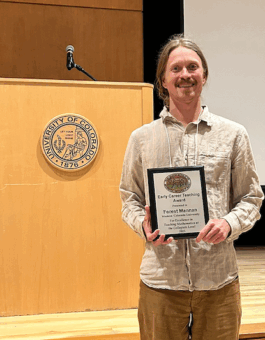Preserving the past while paving the way for the future — that’s the result of a collaborative project between a major corporation, the state’s historical preservation commission and faculty and students at Western.
The project — which took place during July and August 2020 — gave students the opportunity to gain practical skills, making them career-ready when they graduate, better prepared to enter the field of archeology and historical preservation. It also fulfilled requirements by the State Historic Preservation Office for communications company ATandT to begin improving cell phone service to the south end of the Gunnison Valley.
A Historically Significant Site
Communications towers have been a feature for decades, high atop of Tenderfoot Mountain, south of the Western campus. But the mountain is also home to an archeological site dating back to about 12,000 years ago. The site, once inhabited by the Folsom people, a Paleo-Indian people indigenous to Colorado, has long been the focus of Western Professor of Anthropology Mark Stiger and his program at Western.
ATandT decided it wanted to replace an aging cell tower, upgrading it with the latest technology to improve service. Federal and state law requires that before construction permits can be issued at such a location with historical significance, a cultural resource study involving excavation of the area must occur.
ATandT contracted with Western, Anthropology lecturer David Hyde and four Western students who spent five weeks sifting through the soil where the tower would be built. From there, the earth gave up her treasures, revealing more about life on the mountain nicknamed for having the Western “W” emblazoned on its side.

Experience in the Field
The group spent weeks focused on a square plot measuring 8-by-8 meters, with each square meter divided into four quadrants. The soil was excavated down to bedrock with samples brought back to the campus lab for analysis. Through water screening, it was determined 296 of the 655 samples had evidence of artifacts — flakes and other proof that the Folsom people sat at the edge of the mountain and sharpened stone tools.
Perhaps, the group surmised, the Folsom people were eyeing animal movement and observing anyone who may try to approach as they worked. The student archeologists also found a material called “daub,” a baked clay used in building structures.
“I was itching to get some experience in the field and ready to explore Tenderfoot,” said Anthropology student Remy Schultz, who graduated five months following the dig. “Mostly, I learned how to identify the materials that the Folsom tools were made from, how to set up a test-pit, keep good field notes, and I learned about daub, a rock which indicates hearth and fire use when it’s charred.”
Enhancing Education
Developing those skills, Hyde said, gives students an edge as they enter their professional fields. Cultural resource management, he said, is a primary function of trained archeologists, as historical sites are nonrenewable resources. The methodology of analyzing a site and the critical thinking required are essential to the work, he said, and aren’t always fully realized in the classroom. Field work, Hyde said, although sometimes mundane, enhances a new graduate’s ability to jump right into the industry.
But Schultz took far more than technical skills away from the dig. Following the discovery of an ashen pit, Schultz brought his best thinking into interpreting what the artifacts mean. By doing so, he brought a modern-day interpretation to events which occurred tens of thousands of years ago, providing clues to the essence of humanity.
“I constantly wonder about the interplay between mountain and Folsom—about the human ethnosphere,” Schultz said, ruminating on his experience. “What could be their knowledge contribution to the way we live life in Gunnison now? What did they believe in? What are we forgetting that they knew? And how exactly did they regard the mountain like us?”
Those kinds of questions essentially bring life to mere fragments of history, giving us insight to the past and even present.
An Ongoing Project
Following a preliminary report by Hyde on the excavation, the State of Colorado will provide ATandT a permit to begin construction. However, the final report due in three years is an ongoing project for the anthropology lecturer. Meanwhile, Hyde shares the lessons from the excavation in the classroom.
“It was fun and interesting,” said Hyde. “We used this experience in the fall 2020 semester in archeology class. We took some of the artifacts, looked at them an analyzed them, to see the laboratory side of the process.”
Interested in hands-on learning experiences? Learn more about the Western Colorado University Anthropology program.
Author Credit: Chris Rourke
Photo Credit: Western Anthropology


